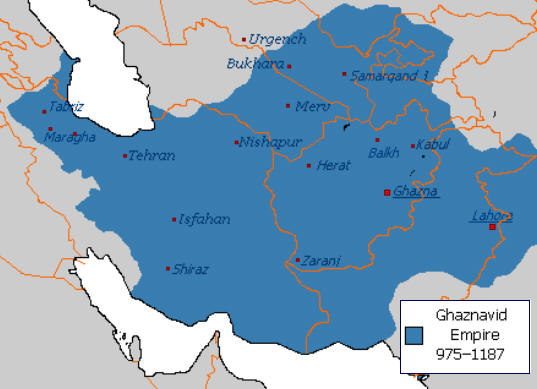Alamgir
Elite Member
- Messages
- 347
- Reaction score
- 7
- Gender
- Male
- Religion
- Islam
Mahmud Ghaznavi was a Mujahid from Khorasan (a historical region that covered Afghanistan, Pakistan, eastern Iran and Central Asia) who ruled over the Ghaznavid Empire for a period of 32 years, from 998 to 1030 AD. He was also the first ruler to use the title of Sultan, which means "authority" in Arabic. Under his leadership, the Ghaznavid Empire expanded to include most of Afghanistan, Pakistan, Central Asia and Iran, with it's two largest cities being Ghazni (Afghanistan) and Lahore (Pakistan), both of which acted as the capitals of the empire on rotation (Ghazni in the summer, Lahore in the winter).

Mahmud Ghaznavi's biggest achievement was the sheer number of ghazwa's he launched into Al Hind (what's today known as Hindustan), in fact, Mahmud Ghaznavi is said to have pledged to launch a ghazwa into Al Hind once a year, destroying/damaging many temples and idols while also crushing nearby Hindu kingdoms so they could pose no threat to Darul Islam. His most famous ghazwa was the one carried out in Somnath, where he damaged one of the holiest temples in Hinduism (the Somnath Temple) and destroyed its idol, while also carrying away roughly 2,000,000 dinars worth of loot.
The famous Muslim polymath Al Biruni had this to say about Mahmud Ghaznavi:
"Allah be merciful to both father and son! Mahmud utterly ruined the prosperity of the country [India], and performed wonderful exploits, by which the Hindus became like atoms of dust scattered in all directions, and like a tale of old in the mouth of the people"
Mahmud Ghaznavi maintained a large and powerful army which was vastly multi-ethnic, consisting of Turks, Pashtuns, Persians, Hindkowans and Punjabis, his army was also one of the first Muslim army's to make use of war elephants.
The Ghaznavids were one of many Muslim dynasties to wage jihad across South Asia, and the effects of these ghazwa's are still seen today, with the countries of Afghanistan, Pakistan and Hindustan now all having large numbers of Muslims living in them, which most historians attribute to the work of the Ghaznavids. The lingua franca of Muslims in Pakistan and Hindustan (Urdu) is also written in a Perso-Arabic script, with many Persian, Arabic and Turkic loanwords, influenced by the many Mujahids from Iran, Central Asia and Arabia that came to the region during these conquests. The Muslims of Pakistan and Hindustan have also been shown to have higher amounts of ancestry from Central Asia, Iran and Arabia as compared to their Hindu counterparts, which would also come from migrants to the region during these Islamic conquests. The Pakistani military also named a nuclear missile after Mahmud Ghaznavi (it's called the Ghaznavi missile).
Sources:
Maḥmūd | king of Ghazna
Translation of the Tarikh-i-Sultan Mahmud-i-Ghaznavi
Mahmud of Ghazni
http://pu.edu.pk/images/journal/studies/PDF-FILES/Artical-4_v16_1.pdf
Genetic markers in the Hindu and Muslim Gujjars of Northwestern India.
Microsatellite diversity delineates genetic relationships of Shia and Sunni Muslim populations of Uttar Pradesh, India.
Traces of sub-Saharan and Middle Eastern lineages in Indian Muslim populations

Mahmud Ghaznavi's biggest achievement was the sheer number of ghazwa's he launched into Al Hind (what's today known as Hindustan), in fact, Mahmud Ghaznavi is said to have pledged to launch a ghazwa into Al Hind once a year, destroying/damaging many temples and idols while also crushing nearby Hindu kingdoms so they could pose no threat to Darul Islam. His most famous ghazwa was the one carried out in Somnath, where he damaged one of the holiest temples in Hinduism (the Somnath Temple) and destroyed its idol, while also carrying away roughly 2,000,000 dinars worth of loot.
The famous Muslim polymath Al Biruni had this to say about Mahmud Ghaznavi:
"Allah be merciful to both father and son! Mahmud utterly ruined the prosperity of the country [India], and performed wonderful exploits, by which the Hindus became like atoms of dust scattered in all directions, and like a tale of old in the mouth of the people"
Mahmud Ghaznavi maintained a large and powerful army which was vastly multi-ethnic, consisting of Turks, Pashtuns, Persians, Hindkowans and Punjabis, his army was also one of the first Muslim army's to make use of war elephants.
The Ghaznavids were one of many Muslim dynasties to wage jihad across South Asia, and the effects of these ghazwa's are still seen today, with the countries of Afghanistan, Pakistan and Hindustan now all having large numbers of Muslims living in them, which most historians attribute to the work of the Ghaznavids. The lingua franca of Muslims in Pakistan and Hindustan (Urdu) is also written in a Perso-Arabic script, with many Persian, Arabic and Turkic loanwords, influenced by the many Mujahids from Iran, Central Asia and Arabia that came to the region during these conquests. The Muslims of Pakistan and Hindustan have also been shown to have higher amounts of ancestry from Central Asia, Iran and Arabia as compared to their Hindu counterparts, which would also come from migrants to the region during these Islamic conquests. The Pakistani military also named a nuclear missile after Mahmud Ghaznavi (it's called the Ghaznavi missile).
Sources:
Maḥmūd | king of Ghazna
Translation of the Tarikh-i-Sultan Mahmud-i-Ghaznavi
Mahmud of Ghazni
http://pu.edu.pk/images/journal/studies/PDF-FILES/Artical-4_v16_1.pdf
Genetic markers in the Hindu and Muslim Gujjars of Northwestern India.
Microsatellite diversity delineates genetic relationships of Shia and Sunni Muslim populations of Uttar Pradesh, India.
Traces of sub-Saharan and Middle Eastern lineages in Indian Muslim populations
Last edited:
